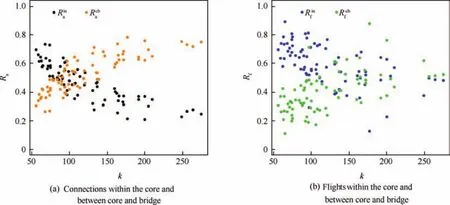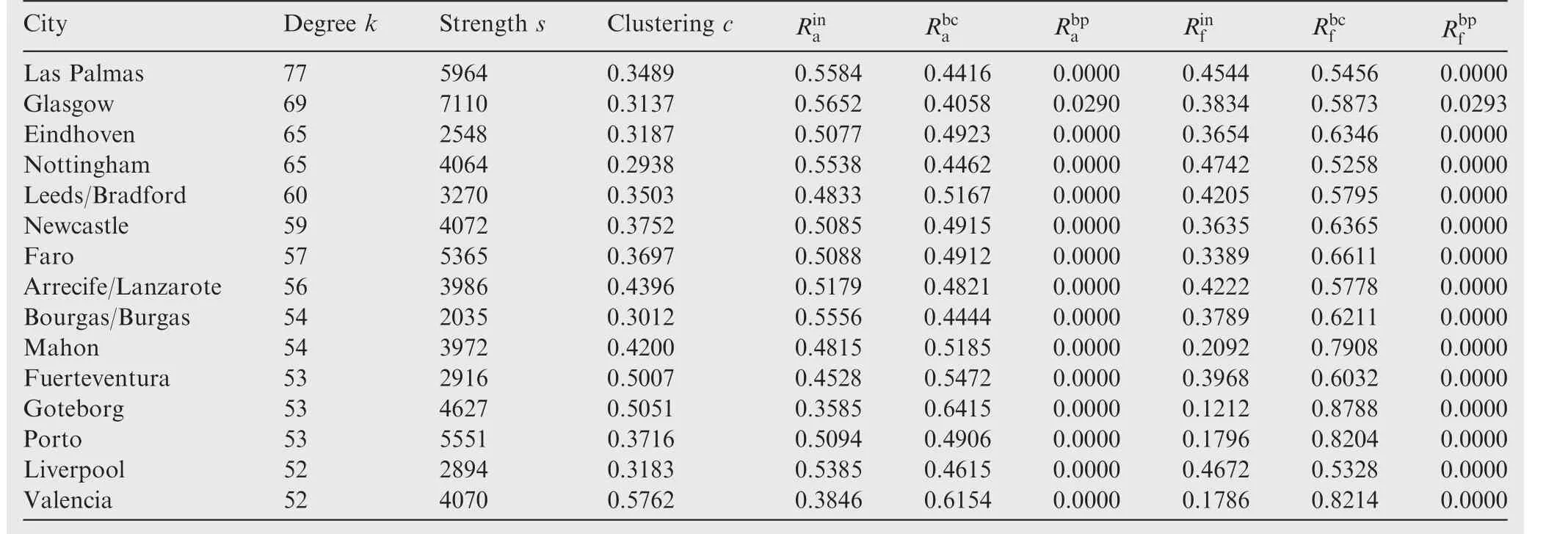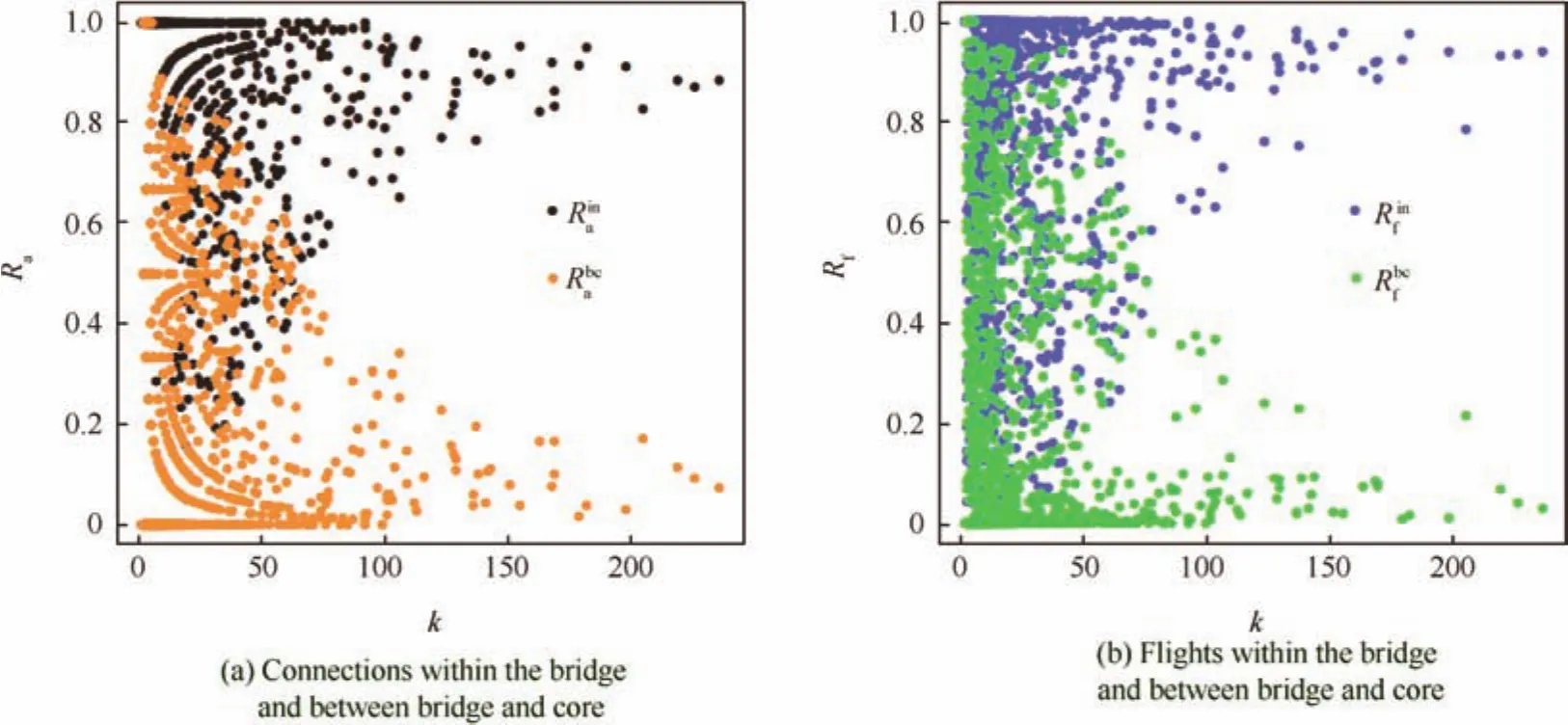Analyzing the multilevel structure of the European airport network
2017-11-20OriolLordanJoseSallan
Oriol Lordan,Jose M.Sallan
Department of Management,Universitat Polite`cnica de Catalunya-BarcelonaTech,Terrassa 08222,Spain
Analyzing the multilevel structure of the European airport network
Oriol Lordan*,Jose M.Sallan
Department of Management,Universitat Polite`cnica de Catalunya-BarcelonaTech,Terrassa 08222,Spain
Air transport networks;Complex networks;k-core decomposition;Network multilevel structure;Robustness
The multilayered structure of the European airport network(EAN),composed of connections and flights between European cities,is analyzed through thek-core decomposition of the connections network.This decomposition allows to identify the core,bridge and periphery layers of the EAN.The core layer includes the best-connected cities,which include important business air traffic destinations.The periphery layer includes cities with lesser connections,which serve low populated areas where air travel is an economic alternative.The remaining cities form the bridge of the EAN,including important leisure travel origins and destinations.The multilayered structure of the EAN affects network robustness,as the EAN is more robust to isolation of nodes of the core,than to the isolation of a combination of core and bridge nodes.
1.Introduction
Since its inception in the beginning of the 21st century,the development of aeronautics and air travel has deeply transformed economy and society.The fact that trips that lasted days or even weeks or months can be done today in a few hours has brought closer countries and civilizations,and the impact of air travel can only be paired with the development of the internet.A common feature of air travel and the internet is that both are networked infrastructures.In the case of air travel,the aggregation of commercial decision of airlines hascreated air route networks,where the nodes are airports or cities connected by edges when there is at least a direct flight between them.
Complex network theory is a powerful tool to investigate networked systems such as air route networks.Taking a systems theory approach,complex network theory investigates the influence of topological features of real-world networks on phenomena such as network robustness or propagation.The results of complex networks theory have been applied extensively to the study of air transport networks.Guimera`and colleagues1,2were the first to analyze the world air route network,finding that the central cities were not necessarily the best connected nodes.Lordan et al.3analyzed the robustness of the world airport network(WAN),finding that the most effective criterion to break up the WAN is to disconnect the most central nodes(i.e.,the nodes with highest betweenness centrality).
Regional airport networks can have different properties from the world airport network.It has been found that airport networks can have different properties depending on season(summer or winter),species(business or leisure)or scale(route vs origin-destination).4Extant research has found that the WAN has a multi-community structure2so regional networks can be different from the global network.Regional airport networks share similar topological features,although had remarkable differences in evolution and growth.For instance,while the Chinese airport network is experiencing a rapid development,5in the Brazilian network,although the number of passengers has increased,the number of routes has decreased as airlines focus on more profitable routes.6
One of the central elements of the WAN is the European airport network(EAN),which includes all routes between European airports that have at least a direct flight.The EAN is a reflection,and a consequence,of the social and economic development of Europe.Considering Official Aviation Guide(OAG)Flights(http://analytics.oag.com/)data from August 2014,the European network has less nodes than the North-American(601 vs 899),but considerably more direct connections between airports(6401 vs 3540).
A distinctive feature of airport networks is that they are the result of the aggregation of decisions taken by airlines about their route portfolio,which in turn are the result of different airlinebusinessmodelsand theirintegration in airline alliances.7This fact leads to consider that a more realistic modeling of airport networks can be obtained if its multi-layered structure is taken into account.Cardillo and colleagues8modeled the EAN as a network of 15 layers,corresponding to the route networks of the largest European carriers,while Verma et al.9and Du et al.10analyzed the WAN and the Chinese airport network,respectively,defining three layers for airport networks based on thek-core decomposition.11These analyses showed that the analysis of the multi-layered structure of airport networks offered remarkable insights about their properties,such as network structure and robustness.
The aim of this paper is to model and to analyze the EAN as a multi-layered network,to better understand its internal organization and the network properties that determine its robustness to the isolation of nodes chosen either at random(attacks),or chosen intendedly as relevant or central(attacks).In the next section,a topological analysis of the EAN will be undertaken,including the analysis of its core,bridge and periphery layers.Then,a robustness analysis will be carried out,paying special attention to the role that airports of cities belonging to core and bridge play in robustness of the EAN.The results obtained,and a reflection about their operational implications,will be reported in the conclusions section.
2.Topology of the EAN
A sample of the EAN was obtained by including all flights between European cities(includingCanary Islandsand Madeira)in August 2014 covered by the OAG dataset.The EAN was described through its adjacency matrix A,whereaij=1 if citiesiandjare connected through at least a direct flight andaij=0 otherwise.To allow comparison of results with previous research,2,10,12,13airports serving the same city(e.g.,London City Airport and Heathrow Airport)have been collapsed into one node.The resulting network has 601 nodes and 6401 connections.The degree of a nodekiis equal to its number of connections:


EAN has a global clustering coef ficient ofC=0.62 and average path lengthL=4.04,so it can be considered a small world network.To assess the weight of a connection,a weight matrix W has been de fined,wherewijis equal to the number of flights scheduled in August 2014 between citiesiandj.The network considered has a total of 652291 flights.The strength of a nodesiis equal to the sum of weights of edges departing from nodei:

The multi-layer structure of the EAN can be analyzed through thek-core decomposition of its adjacency matrix.Ak-core of a graph is any subgraph which has nodes with degree equal or larger thank.18This decomposition allows to classify the nodes of the EAN in three subsets or layers9,10:the core contains the nodes belonging to thek-core of maximumkand the periphery the nodes included in thek=1 core.The rest of the nodes belong to the bridge.In Table 1 is reported the number of connections in and between core,bridge and periphery.

2.1.Core layer:global European city

There are 25 cities of the core whereRcab>Rian,of which the first 17 are coincident with the cities of highest degree shown in Table 2.Of the remaining eight cities,four are also among the 25 core cities with highest degree(Manchester,Antalya,Malaga and St.Petersburg).The other four cities are Birmingham,Stuttgart,Alicante and Tenerife.These cities connect the core of the EAN to the bridge,playing a central role in theconnectivity of the European air travel system.It must be noted that most of these cities belong to Western Europe,Russia and Turkey.Some of these central cities are business destinations and hubs of full-service carriers(e.g.,London,Paris,Amsterdam and Frankfurt),while other destinations are mainly leisure(e.g.,Palma de Mallorca,Malaga or Tenerife).

Table 1 Number of nodes,direct connections and flights in core(co),bridge(br)and periphery(perip.,pe)of the European airport network,together with connections and flights between core,bridge and periphery.

Table 2 Top 17 airports of the European core layer.

Fig.1 Connections within the core(Rian)and between core and bridge(Rcab),and flights within the core(Rifn)and between core and bridge(Rcfb)for the nodes of the core layer.
2.2.Bridge layer:leisure air travel origins and destinations

In Fig.2(a)are depicted the values ofRianandRbacas a function of degreek,and in Fig.2(b)are representedRifnandRbfcalso as a function ofk.Fig.2(a)shows that bridge nodes with low degree are mainly connected to the core,as they have high values ofRbac,while bridge nodes with high degree have low values ofRbacso they are connected mainly with other cities of the bridge.This results are different from the analysis of Du et al.10for the Chinese network.In the Chinese network,most bridge nodes,even the ones with highest degree,have val-ues ofRbacabove 0.5.Results of Fig.2(b)for flights reveal a similar pattern as in Fig.2(a)for connections.The existence of bridge nodes with high degree with connections mainly with other bridge nodes can be explained by that these cities are senders and receivers of touristic traf fic,thus con figuring a subnetwork of cities belonging to the bridge layer.

Table 3 Top 15 airports of the European bridge layer.

Fig.2 Connections within the bridge(Rian)and between bridge and core(Rbac),and flights within the bridge(Rifn)and between bridge and core(Rbfc)for the nodes of the bridge layer.
Fig.3 shows additional information about the relationship of ratios of connections and flights for the core and the bridge layers.In Fig.3(a)can be seen thatRifnis larger thanRianor the nodes of the core layer.A reversed relationship can be observed in Fig.3(b)betweenRcfbandRcab.This results reveal that the routes within the core layer are the ones with most flights scheduled.The average number of flights per connection within the core layer is 185.44,and the same ratio falls to 82.07 for routes between bridge and core(data taken from Table 1).This result reinforces the idea that the European airport network has a core of strongly knit cities(in number of routes and in number of scheduled flights).
2.3.Periphery layer:local destinations
The periphery layer has low significance in EAN connectivity.Consists of 88 nodes(14.64%of total nodes),with only 27 connections with the bridge and 63 with the core(see Table 1).In Table 2 can be seen that Moscow,Istanbul,Oslo and Stockholm have signi ficant values ofRcapandRcfp.As most cities of the periphery are located in Russia,Turkey and Scandinavia,the periphery of the EAN consist mainly of local airports in these countries,connected only with a single airport.It is worth noticing that the EAN periphery is quite large,compared with the Chinese airport network,10suggesting that there are more local airports in Europe than in the Chinese airport network.
3.Influence of multilayer structure on EAN robustness
The robustness analysis of the EAN allows to detect the critical nodes19,20or edges21critical to maintain the connectivity of the whole network.Network robustness to node isolation can be assessed through the size of the giant component as a function of the number of disconnected cities.The giant component is the connected component of the network with the largest number of nodes,that is,the largest set of nodes that are connected directly through an edge or indirectly through a path.In a robust network,a significant reduction of the giant component is reached only when a large proportion of nodes is disconnected.

Fig.3 Relationship between ratios of connections and flights of nodes of the core layers.
An important prediction of complex network theory is that network robustness is dependent on degree distributionP(k),the distribution of the probability that a node has degreek.We have used the cumulative degree distributionP(k)cum,the probability that a node has degree larger thank,to report degree distribution.Scale-free networks,with a cumulative degree distribution following a power law,are robust to errors(disconnection of nodes at random)but not to targeted attacks(disconnection of central nodes,chosen with a selection criterion).22,23Fig.4(a)depicts the cumulative degree distribution of the EAN.As stated in Section 2,EAN degree distribution follows a two-regime power law.This degree distribution can make EAN robust to isolation of nodes chosen at random,but not to node selection criterion based on isolation of central nodes.So,a robustness analysis of the EAN can help to detect its critical nodes.
Fig.4(b)shows the size of giant component as a function of the fraction of nodes disconnected following several selection criteria.To simulate errors,a random selection criterion has been tested,and to simulate attacks,three of the most effective node selection removal strategies for airport networks3have been tested:selection of nodes of highest degree and highest betweenness centrality,and selection of nodes of highest damage,being damage the reduction of size of giant component when a specific node is isolated.All criteria are used adopting an adaptive strategy,that is,node parameters are recalculated after each disconnection.The results of the robustness analysis of the EAN appear in Fig.4(b).Comparing this results with other airport networks,the EAN appears as particularly robust.The most effective node selection criterion,betweenness centrality,needs to disconnect up to 20%of nodes to reduce size of giant component to almost zero.Previous research shows that this fraction is of around 11%of the world airport network,3and around 13%in the Chinese airport network using a degree criterion.8
The multilayer structure of the EAN explains why betweenness is more effective than degree to disconnect the network.If we consider the 60 nodes with highest betweenness,14 belong to the bridge and the rest to the core.But only 4 of the 60 nodes with highest degree belong to the bridge,and the remaining 56 to the core.Then,adopting a degree strategy implies isolating mainly core nodes.As the core is a redundant,strongly knit layer,isolating a core node can have a relatively low impacton sizeofgiantcomponent.Adoptinga betweenness-based selection criterion implies disconnecting bridge nodes in early stages of the process.The disconnection of bridge nodes of high degree can have a bigger impact on network connectivity,as they have a highRbacratio(see Fig.2(a)),and the bridge layer is less connected than the core.This result suggests that other network properties apart from degree distribution can affect network’s response to targeted attacks.

Fig.4 Cumlative degree distribution(in a log-log scale),and size of the giant component(measured as a function of the number of isolated airports),using several node selection criteria.
4.Conclusions
In this research,the multilayer structure of the European airport network is analyzed,defining its three main layers:core,bridge and periphery.The core is thek-core of highest degree.In the case of the EAN includes 69 highly connected cities with a dense web of connections.Being located in one of the core cities mean that it is easy to reach the rest of core cities by plane,so it can be said that core cities shape a global European city connected by flight.The most connected core cities are listed in Table 1.The list shows not only cities which are the hubs of full-service carriers,such as Frankfurt,Paris or Amsterdam,but also cities like Barcelona,Du¨sseldorf or Palma de Mallorca,which are important bases of airlines with a low cost or hybrid business model.
The periphery is thek-core of degree one,so it includes the less connected cities of the EAN.The 88 periphery cities are located mainly in Russia,Turkey and Scandinavia.
The remaining 444 cities are included in the third layer,the bridge.As can be seen in Fig.1,the bridge is connected to the core through the core cities nodes of highest degree.Bridge nodes of low degree have a large proportion of connections and flights with core cities.This fact,together with the high density of the core layer,leads to high values of clustering coefficient for these cities.Bridge nodes of high degree,on the con-trary,have a large proportion of connections with other bridge nodes(see Fig.2).Bridge cities of highest degree are listed in Table 3.Most of these cities have mainly leisure traffic,as they are origins(Glasgow,Eindhoven,Nottingham)and destinations(Las Palmas,Faro,Lanzarote)of trips of Northern European tourists to South European vacation destinations(and in reverse).A large part of this demand is covered(and created)by low-cost carriers.The structure of the core and bridge of the EAN shows the importance of airlines with a low-cost or hybrid business model in the European air traffic market.24
It is possible to compare the multilayer structure of the EAN with other airport networks,such as the Chinese.10The proportion of cities in the bridge is similar(around 74%)in both networks,but the EAN has more cities in the periphery(14%of total)than the Chinese(around 7%).Furthermore,the presence of cities like Las Palmas and Glasgow in the bridge of the European network reveal the existence of an important leisure traffic,served mainly by European lowcost carriers.Finally,the European core layer is smaller than the Chinese,showing that the weight of large airports in Europe is smaller than in China.5,17
The robustness of the EAN to errors(isolation of nodes chosen at random)and attacks(isolation of central nodes chosen with specific selection criterion)has been investigated assessing the evolution of the size of giant component as a function of the proportion of isolated nodes for several node selection criteria,similarly to Lordan et al.3or the robustness analysis of Petreska et al.19for the power grid.As is shown in Fig.4(b),the EAN behaves in a similar way as other airport networks3,25,as the most effective way to disconnect the network is to isolate the nodes with highest betweenness.In the EAN,isolating the nodes of highest degree implies isolating mainly nodes belonging to the core,while isolating the nodes of highest betweenness leads to isolate earlier a larger proportion of bridge nodes.This fact shows that,although degree distribution affects network robustness,other network properties such as its multilayered structure can affect robustness as well.A systematic comparison of regional airport networks might help to explain better the possible influence of the corebridge-periphery structure on network robustness.
1.Guimera`R,Amaral La N.Modeling the worldwide airport network.Eur Phys J B2004;387540(2):381–5.
2.Guimera`R,Mossa S,Turtschi A,Amaral La N.The worldwide air transportation network:anomalous centrality,community structure,and cities’global roles.Proc Natl Acad Sci USA2005;102(22):7794–9.
3.Lordan O,Sallan JM,Simo P,Gonzalez-Prieto D.Robustness of the airtransportnetwork.TransportResE-Log2014;68(68):155–63.
4.Neal Z.The devil is in the details:differences in air traffic networks by scale,species,and season.Soc Networks2014;38(3):63–73.
5.Wang J,Mo H,Wang F,Jin F.Exploring the network structure and nodal centrality of China’s air transport network:A complex network approach.J Transp Geogr2011;19(4):712–21.
6.da Rocha LEC.Structural evolution of the Brazilian airport network.J Stat Mech:Theory E2008;2009(4):P04020.
7.Lordan O,Sallan JM,Simo P.Study of the topology and robustness of airline route networks from the complex network approach:asurveyand researchagenda.JTranspGeog2014;37:112–20.
8.Cardillo A,Zanin M,Gomez-Gardenes J,Romance M,Garcia del Amo AJ,Boccaletti S.Modeling the multi-layer nature of the European Air Transport Network:resilience and passengers rescheduling under random failures.Eur Phys J-Spec Top2013;215(1):23–33.
9.Verma T,Arau´jo NAM,Herrmann HJ.Revealing the structure of the world airline network.Sci Rep2014;4:5638.
10.Du WB,Zhou XL,Lordan O,Wang Z,Zhao C,Zhu YB.Analysis of the Chinese airline network as multi-layer networks.Transport Res E-Log2016;89:108–16.
11.Dorogovtsev SN,Goltsev AV,Mendes JFF.K-core organization of complex networks.Phys Rev Lett2006;96(4):040601.
12.Liu HK,Zhang XL,Zhou T.Structure and external factors of Chinese city airline network.Phys Proced2010;3(5):1781–9.
13.Zhang J,Cao XB,Du WB,Cai KQ.Evolution of Chinese airport network.Phys A2010;389(18):3922–31.
14.Wilkinson SM,Dunn S,Ma S.The vulnerability of the European air traffic network to spatial hazards.Nat Hazards2011;60(3):1027–36.
15.Chi LP,Wang R,Su H,Xu XP,Zhao JS,Li W,et al.Structural properties of US flight network.Chinese Phys Lett2003;20(8):1393–6.
16.Bagler G.Analysis of the airport network of India as a complex weighted network.Phys A2008;387(12):2972–80.
17.Cai KQ,Zhang J,Du WB,Cao XB.Analysis of the Chinese air route network as a complex network.Chin Phys B2012;21(2):028903.
18.Batagelj V,Zaversnik M.An O(m)algorithm for cores decomposition of networks.Comput Sci2003;1(6):34–7.
19.Petreska I,Tomovski I,Gutierrez E,Kocarev L,Bono F,Poljansek K.Application of modal analysis in assessing attack vulnerability of complex networks.Commun Nonlinear Sci2010;15(4):1008–18.
20.Sun X,Wandelt S.Assessment of node importance in air transportation networks using multi-criteria decision analysis.Air transport and operations symposium;2015 Jul 20-23;TU Delft,Netherlands.2015.
21.Du WB,Liang BY,Yan G,Lordan O,Cao XB.Identifying vital edges in Chinese air route network via memetic algorithm.Chin J Aeronaut2017;30(1):330–6.
22.Albert R,Jeong H,Baraba´si AL.Error and attack tolerance of complex networks.Nature2000;406(6794):378–82.
23.Cao XB,Hong C,Du WB,Zhang J.Improving the network robustness against cascading failures by adding links.Chaos Soliton Fract2013;57(4):35–40.
24.Klophaus R,Conrady R,Fichert F.Low cost carriers going hybrid:evidence from Europe.J Air Transp Manage2012;23(7):54–8.
25.Lordan O,Sallan JM,Simo P,Gonzalez-Prieto D.Robustness of airline alliance route networks.Commun Nonlinear Sci2015;22(1–3):587–95.
4 June 2016;revised 19 July 2016;accepted 16 December 2016
Available online 14 February 2017
*Corresponding author.
E-mail address:oriol.lordan@upc.edu(O.Lordan).
Peer review under responsibility of Editorial Committee of CJA.
杂志排行
CHINESE JOURNAL OF AERONAUTICS的其它文章
- Dynamics of air transport networks:A review from a complex systems perspective
- ATM performance measurement in Europe,the US and China
- Network analysis of Chinese air transport delay propagation
- Robustness analysis metrics for worldwide airport network:A comprehensive study
- Evolution of airports from a network perspective–An analytical concept
- Methods for determining unimpeded aircraft taxiing time and evaluating airport taxiing performance
